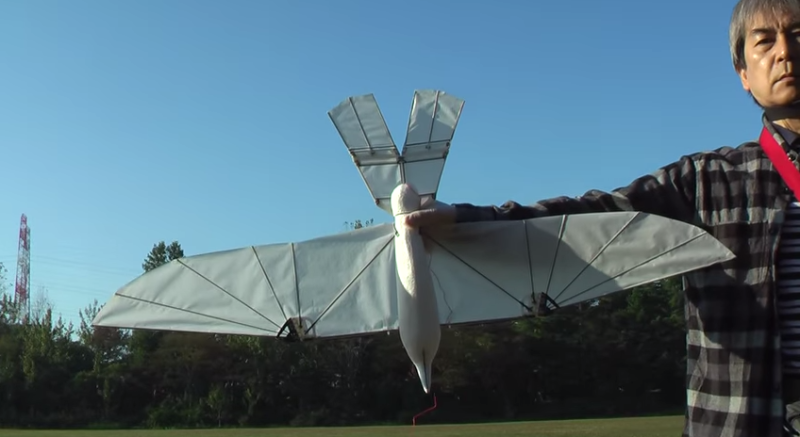Turns out you don’t have to be a multi-million dollar corporation like Festo to create a remote controlled, flapping bird robot. [Kazuhiko Kakuta] is a medical Doctor of Allergy, and in his free time he likes to build flying mechanical birds with his son.
It has just over a meter wingspan, weighs 193 grams, and it flies by flapping its wings. The majority of its components are 3D printed. If that’s not impressive enough for you as is, consider this. It it has no sensors, no gyroscopes or anything — it’s all manually controlled by [Kazuhiko].
And this isn’t even the only ornithopter he’s done. He’s also created something out of an anime film, Castle in the Sky. He even sells the designs for one of them, to be printed via Shapeways.
Previously we’ve only seen an ornithopter this large like this one done by Festo, which makes [Kazuhiko’s] work even more impressive.
[Thanks Nickson!]
















Hmmm, how else would a mechanical bird fly?
Propellers?
That would make it a mechanical aeroplane…
By your logic, copters are also mechanical aeroplanes… Fixed wings make a plane, not the propeller.
does it leave m3 nuts as droppings?
Why 3d print those parts? Waterjet or laser cut them unless you need them to be hollow.
Some parts are hollow, to fit carbon fiber rods in it, but an ornithopter (I own one) has to be very light and therefor parts breaks more often, also 3D parts = less screws and bolts which are heavy.
+1 for using the word ornithopter!
Thats epic!
Very impressive, it looks just like a real bird flying. Except that it never glides.
I was thinking it would be great to have a momentary switch on the remote that put it in ‘glide mode’ when held. You could do some pretty impressive swoops and dives then.
You had me at Studio Ghibli recreations. Awesome.
+1 the laputa ornithopter is amazing
http://youtu.be/rJwIhnFxuWQ?t=25s
RC people (and free flighters) have been doing this for many many decades, so yeah, not all that impressive.
You have a link?
http://www.ornithopter.org/archive.shtml
Go and look the number of videos that guy has.
That’s what makes him impressive,
definitely more impressive than your quick-to-judge comment.
He started doing it at least 4 years ago.
Anything that’s not completely, 100% novel is boring and worthless. So sayeth our lord and master, vonskippy.
“a medical Doctor of Allergy”
An Allergist then.
It might be worth saying that he’s actually a doctor, there are many people who describe themselves as ‘allergist’ who are no more qualified than my cat.
I bet your cat has a pretty good record identifying people with allergies to cat hair/dander!
That’s great :) Reminds me of Tim the Bird that I had when I was a kid ( http://www.tigertribe.com.au/Flying-BIrd ). The landings are a bit harsh, though!
Flaptter is MUCH more interesting than this bird.
Can anyone compare the efficiency of this type of flight compared to a model plane? (similar size, weight etc)
Yea, this one has terrible MPG.
Airplanes are much more efficient.
Predator dronepelican ??? cool
This is really well made. Now slap a decent microcontroler in it, a GPS, altimeter, accelerometer, gyroscope and make it autonomous. For the kicks, add in a thermal camera as well and make it take advantage of the hot air currents like birds do to minimize flight energy.
well a thermal camera won’t be able to detect surrounding air temperature gradients but you get the point.
Solar cells for additional power…
hws tht dn exactly?gps?????????
This seems like an old story.
“New hacks every day”?
since the top video say 10/Oct/2014 it makes it a ripe old 3 days old
Pentagon plans [better] cyber-insect army (March 2006)
http://news.bbc.co.uk/2/hi/americas/4808342.stm
In February 2007, scientists at the Robot Engineering Technology Research Centre at Shandong University of Science and Technology in China announced they had created remote-controlled pigeons.
If you need a theme song to go with this, try Disney’s “Shutterbug Time” about cyber-insect spies “sending your picture right up to the satellite.”
Would hate to join the crowd of Hackaday haters, but ornithopters are part of the earliest forms of flight known to man. Lawrence Hargrave made rubber band powered ornithopters in the 1890’s, and some were amazingly lifelike. Not only this, but commercial ornithopters have been available for many decades, including small ones in toy stores.
This reminds me of the wind-up toy birds I played with as a kid.
Good times…
It reminds me of the “bird” in “It’s a Bug’s Life”
An FPV video from either of these ornithopters would be very cool.
Any Building plans?